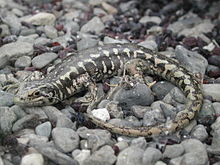Otago skink
| Otago skink | |
|---|---|

| |
| Scientific classification | |
| Kingdom: | |
| Phylum: | |
| Class: | |
| Order: | |
| Suborder: | |
| Family: | |
| Genus: | |
| Species: | O. otagense
|
| Binomial name | |
| Oligosoma otagense McCann, 1955
| |

| |
The Otago skink, Oligosoma otagense, is an endangered species of large skink of the family Scincidae, found in the central Otago region of New Zealand.
Physical characteristics
Otago skinks are large compared to other New Zealand skinks, capable of growing to lengths up to 12 inches (31 cm). They are marked with distinctive black, yellow, and green spots, which provides excellent camouflage in their rocky habitat of lichen-covered rocks and schist outcrops. Like most skinks, Otago skinks are omnivores and feed on a wide variety of insects and fleshy fruits. They are long lived (up to 40 years), slow to mature (3 to 4 years), and give birth to 3 or 4 live and independent young in January to March each year.
Habitat

Otago skinks are only found in very specific locations in Otago, and are typically limited to the large schist rock outcroppings found in that region. They can often be seen sunning themselves on these rocks and seek refuge in the deep crevices when alarmed, at night and on cold days. As of 2000, the range of the Otago skink has decreased by roughly 90% when compared to the estimated historic range. Although it was once widespread, land use change, particularly the intensification of farming, and the introduction of mammalian predators has led to a decline in the population.
Conservation status
As of 2012 the Department of Conservation (DOC) classified the Otago Skink as Nationally Endangered under the New Zealand Threat Classification System.[1] Work to identify the causes of decline is ongoing, as are protection efforts through habitat protection, predator-proof fencing and predator control.[2]
References
- ^ a b Hitchmough, Rod; Anderson, Peter; Barr, Ben; Monks, Jo; Lettink, Marieke; Reardon, James; Tocher, Mandy; Whitaker, Tony. "Conservation status of New Zealand reptiles, 2012" (PDF). Department of Conservation. The Government of New Zealand. Retrieved 18 July 2015.
- ^ Norbury, Grant. "Mokomoko Dryland Sanctuary". Landcare Research - Manaaki Whenua. Landcare Research - Manaaki Whenua. Retrieved 18 July 2015.
- Template:IUCN2006 Listed as Vulnerable (VU C2a v2.3)
- Journal of the Royal Society of New Zealand, Volume 27, Number 4; pp 439-450.
External links
 Media related to Oligosoma otagense at Wikimedia Commons
Media related to Oligosoma otagense at Wikimedia Commons Data related to Oligosoma otagense at Wikispecies
Data related to Oligosoma otagense at Wikispecies- Video of Grand and Otago skinks
- Draft Recovery Plan for Grand and Otago skinks

